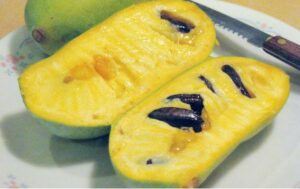 It’s been said that showing up is 80% of life. Showing up during a pandemic looks different than it did “before March 2020”, my term for pre-Covid life. One method the Clackamas FCH team chose to show up is through an increased social media presence. It was a “Hey, you two should meet,” Facebook introduction from my friend and fellow Master Food Preserver, Amanda, that led to Meagan McKenney, the communications director at the Home Orchard Education Center, (HOEC).
It’s been said that showing up is 80% of life. Showing up during a pandemic looks different than it did “before March 2020”, my term for pre-Covid life. One method the Clackamas FCH team chose to show up is through an increased social media presence. It was a “Hey, you two should meet,” Facebook introduction from my friend and fellow Master Food Preserver, Amanda, that led to Meagan McKenney, the communications director at the Home Orchard Education Center, (HOEC).

The HOEC is a demonstration orchard, offering horticulture education, volunteer opportunities (Learning and free fruit in exchange for work? Heck yeah!), and has a CSA program, nestled in 1.6 acres of the Clackamas Community College campus. They offer CSA fruit share options and host regular workshops. They also sell a huge assortment of custom grafted heirloom apple and pear trees, as well as fruit scions.
Back up though…let’s quickly talk about the term CSA. It stands for Community Supported Agriculture and, quoting the HOEC website: “Community Supported Agriculture (CSA) is a mutually beneficial harvest sharing model, based on a relationship between Farmer and Customer. Rather than simply purchasing fruit, customers become “Supporting Subscribers” of the farm, and in trade receive a portion of the harvest. Proceeds from this program help keep the gates to our well-loved arboretum open and support our mission to provide affordable, fruit-focused education to the community.” Beautiful, isn’t it? I could talk all day about CSAs, and maybe I will in the future, but let me just add that the payment method for CSAs has changed over time. It used to be that you paid one lump sum at the beginning of the season. Times have changed. Many farms offer the option to divide the share price into payments. Some farmer’s accept monthly EBT payments. Because everyone, in all income levels, deserve farm fresh food. I call it eating with dignity.

Anyway…stepping off my soapbox…The Home Orchard Education Center offers three different CSA options, one of which is an Orchard Sampler Box. The subscriber gets 17 boxes throughout the year, containing different varieties of fruit. It’s a great way to learn about new fruit, like the pawpaw.

In my previous career as a produce buyer, I’d heard of pawpaw, but until now had very little knowledge of them. When ripe, the fruit is custard-like and tastes tropical. It’s an indigenous East coast native that grows well in the PNW. It has soft flesh (when ripe) and a number of large seeds. Its leaves are the main food source for the zebra swallowtail butterfly, it’s pollinated by flies (the blossoms smell funky), and the bark is used as a natural insecticide. It may not be widely available commercially because it has a short season, bruises easily, and should be picked when ripe, because it doesn’t ripen well off the tree. It transitions from rock hard to mush and the flavor isn’t great. I also learned that cooking it really doesn’t do the flavor justice. It tastes more banana-like; you might as well use bananas.

The HOEC grows pawpaw and includes it in their CSA. Meagan asked if OSU knew why some folks suffer gastric distress after eating unripe or dehydrated pawpaw, such as in fruit leather. It proved to be a challenging question without a clear food science answer, but led me down a very interesting rabbit hole: learning about pawpaw, its place as an indigenous food (perfectly timed, I just watched the film, Gather, last week), research programs across the country, a recently arrived magazine article shared by my buddy and Master Food Preserver volunteer, Don, and a final recommendation with hope of future research from the food science community.
Folks are making ice cream, booze, pies, and custards with pawpaw. There are all sorts of creative ways to enjoy them but fruit leather isn’t recommended. Until we know more, and I’m really hoping someone does a research project on this, Joy Wait-Cusic, associate professor and food safety specialist at Oregon State University recommends freezing the ripe pulp, and avoiding making quick cooking breads, such as waffles with it.
I want to thank y’all for sticking around . I had a bit of a gap between posts, longer than planned. The holidays are behind us, although, a friend/former retail co-worker used to say that the “holidays” start in October and end in February, so I guess we have a couple of weeks left. Be kind to yourselves. There’s a lot going on, but chin up! The planting season is just around the corner. I plan to retire with a cup of peppermint tea and my seed catalogs tonight, dreaming of and planning for the future. If you have a favorite farm, think about supporting them by subscribing to their CSA. It helps pay for the seeds and equipment to start another glorious season.
Keep up the good work. Stay curious and be excellent to each other.
Buffy Rhoades| mom. forager. gardener. volunteer turned program assistant. a real busy beaver
![]()
![]()
![]() Healthy Together Newsletter Website
Healthy Together Newsletter Website